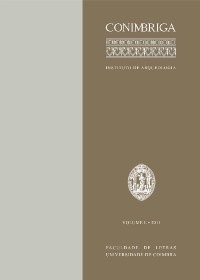Please use this identifier to cite or link to this item:
https://hdl.handle.net/10316.2/35087| Title: | Monte Molião: um sítio púnico-gaditano no Algarve (Portugal) | Other Titles: | Monte Molião: a punic-gaditanian site in Algarve (Portugal) | Authors: | Arruda, Ana Margarida Sousa, Elisa Pereira, Carlos Lourenço, Pedro |
Keywords: | Monte Molião;Iron Age;amphorae;Greek pottery;Kuass pottery;Monte Molião;Idade do Ferro;ânforas;cerâmica grega;cerâmica de Kuass | Issue Date: | 2011 | Publisher: | Faculdade de Letras da Universidade de Coimbra | Abstract: | Monte Molião, localizado na costa ocidental do Algarve (Portugal),
foi ocupado entre o último quartel do século IV a.n.e. e o século II.
Da sua ocupação pré-romana existem dados sobre a arquitectura e
técnicas construtivas, bem como abundantes materiais arqueológicos.
Relativamente aos primeiros, destaca-se um urbanismo ortogonal,
estruturado em torno de arruamentos e áreas abertas, mas também
uma muito particular técnica de construção, consubstanciada no
afeiçoamento e corte do substrato rochoso para implantar os alicerces
das habitações e obter a base dos pavimentos. O conjunto artefactual
cerâmico é composto por ânforas, cerâmica de mesa (grega e de tipo
Kuass) e de uso comum, esta última produzida quer a torno quer à mão.
Em todos os grupos, à excepção, como é óbvio, da cerâmica grega e
da manual, as produções da Andaluzia meridional são maioritárias, o
que evidencia uma profunda ligação à área gaditana, situação que tem
paralelos em outros sítios do Algarve litoral, e que parece demonstrar a
grande vitalidade e preponderância que a antiga colónia fenícia assume
nos momentos finais da Idade do Ferro. Monte Molião, in Algarve´s Western coast, was occupied between the 4th century B.C.E. and the 2nd century AD. From the pre-Roman occupation, there are data concerning the architecture and construction techniques, as well as abundant archeological materials. The architecture plan develops around open spaces, in an orthogonal urbanism. The construction techniques are primarily characterized by the sculpting of the bedrock for the implantation of the buildings foundations. The pavements were also sculpted in the bedrock. The ceramic assemblage is composed by amphorae, table ware (Greek and Kuass), common and handmade pottery. In all of these categories, except for the Greek pottery and the handmade pottery, the productions from the south of Andaluzia are overwhelming, which shows a deep connection with the Cádiz area, situation that has already observed in other archeological sites in the Algarve coast. This seems to show the great vitality and preponderance that the ancient Phoenician colony assumes in the late phase of the Iron Age. |
URI: | https://hdl.handle.net/10316.2/35087 | ISSN: | 1647-8657 | DOI: | 10.14195/1647-8657_50_1 |
| Appears in Collections: | Conimbriga |
Files in This Item:
| File | Description | Size | Format | |
|---|---|---|---|---|
| cn50_artigo1.pdf | 2.28 MB | Adobe PDF |  |
Items in DSpace are protected by copyright, with all rights reserved, unless otherwise indicated.
